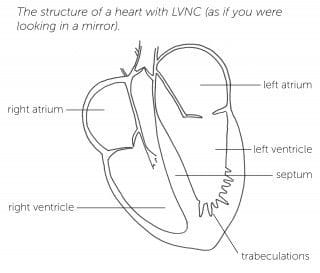Left ventricular noncompaction (LVNC) is a condition of the heart where the walls of the left ventricle, the bottom left chamber of the heart, retain an unusually loose or spongy texture (non-compacted). This leads to the formation of trabeculations, or channels, in the heart muscle, giving the left ventricle a spongey, honeycomb-like appearance.
While it predominantly affects the left ventricle, it can also involve the right ventricle. LVNC can impact the heart's ability to pump blood effectively and may lead to arrhythmias. It is sometimes associated with other forms of cardiomyopathy, such as dilated or hypertrophic cardiomyopathy.
The following diagram, courtesy of CardiomyopathyUK




